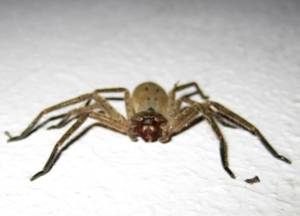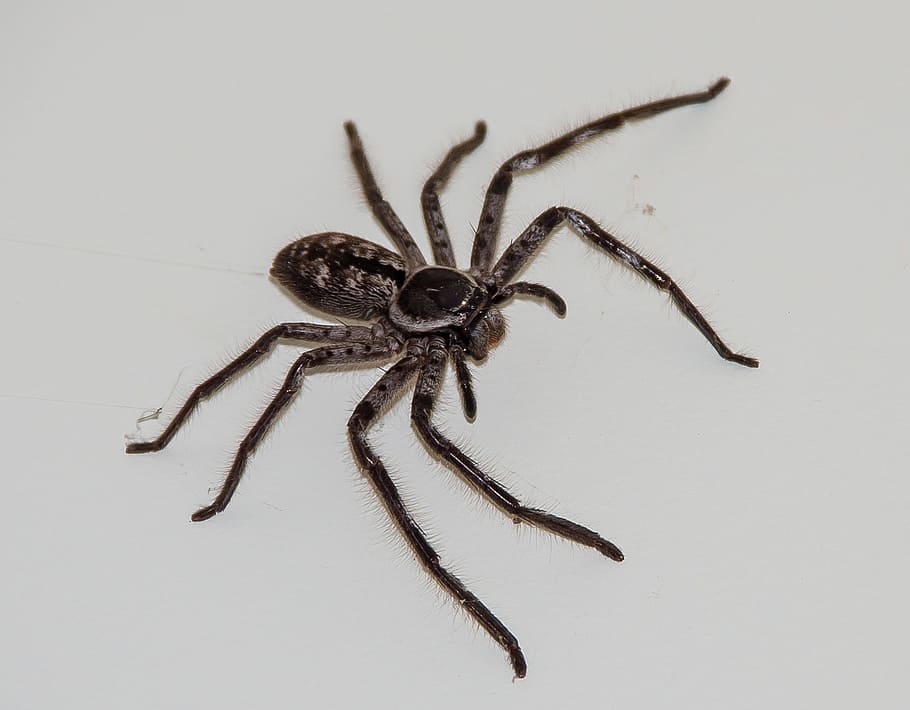Although the size and appearance of a huntsman spider is enough to scare many people away, in truth, they are mostly harmless to humans and in fact beneficial to the environment and our ecosystem.
Read on to find out makes these spiders special, and what you should do the next time you run into one.
Size and Appearance
Most huntsman spiders are either grey or brown, with four long legs on each side and an average leg span of 23 to 30cm. Each body part has slight variations in colour, giving the huntsman a great sense of camouflage, especially in the presence of trees or rocks. Some species of huntsman are more colourful than others. For example, the Badge Huntsman (Neosparassus) often has a colour combination of white, black, orange, and even yellow on the underside of their abdomen.
Lifecycle
In order to mate with virgin females, the male huntsman spiders seek out females who are yet to mature and guard them for a while.
 The female huntsmen lays around 200 eggs in their lifetime, serving as an attentive and protective mother for the majority of their life. The eggs themselves are flat, oval egg sacs of silk, which are most often put in a sheltered spot and protected by the mother. It usually takes around 3 weeks for the eggs to hatch, and in the lead up to this the mother will be prone to attacking any who disturb the area.
The female huntsmen lays around 200 eggs in their lifetime, serving as an attentive and protective mother for the majority of their life. The eggs themselves are flat, oval egg sacs of silk, which are most often put in a sheltered spot and protected by the mother. It usually takes around 3 weeks for the eggs to hatch, and in the lead up to this the mother will be prone to attacking any who disturb the area.
Once the baby huntsman spiders hatch, they appear quite pale at first. But, over time, their colour gets darker as they moult and grow. One way to spot the early signs of a huntsman is to look for old skins that have been shed.
Most huntsman spiders only socialise in order to mate. However, some spiders, like the Delenacanderides, live under the bark of trees, congregating with groups of up to 150 other spiders.
Indeed, if you uncover such a large group of huntsman spiders, you should contact a licensed pest expert to get expert advice and – if necessary – a custom treatment plan.
Do Huntsman Spiders Bite?
If provoked, both male and female huntsman spiders can bite. However, while the huntsman does technically pierce the skin, their venom is only toxic to insects and does not affect humans.
This is because the average huntsman relies on speed and agility to escape their predators. So, when they do bite, the action is done in a fast and swift manner before jumping away from danger.
However, there is one species with venom that can be toxic to humans, and that is the badge huntsman.
When a person is bitten by a huntsman, they may experience mild symptoms, the severity of which canvarybased on the species and person. The most common bite symptoms are localised pain and swelling, headaches, and mild nausea. Usually they last for only a few hours.
Treating a Huntsman Spider Bite
There are a number of ways to provide relief to huntsman spider bites.
First, encourage the person to sit down and relax. Then use water and disinfectant to clean the bite. Apply an ice pack to the bite area, but do not apply pressure as this may worsen the pain. The combination of cleaning and use of an ice pack will help ease the pain and swelling, at least until the wound heals naturally.
If possible, try to collect the spider who bit the person. Take note of its visual traits and research online to identify the species. This information will tell you whether the venom is potentially harmful or not.
If symptoms do not improve, seek out urgent medical attention.
Got a major problem with invasive huntsman spiders? Request treatment from All Bugs today.
Do Huntsman Spiders Jump?
Huntsman spiders do have the ability to jump in a fast, spring-like fashion due to their long legs. For this reason, some observersrefer to them as ‘giant crab spiders.’ They will typically jump while in the process of running, which enables them to cover 30 to 40 times their body length in one second. This is in fact half the maximum speed of Jamaican former sprinter Usain Bolt!
Preferred Homes and Habitats
During the day, most huntsman spiders prefer to retreat in protected areas, like under rocks and the bark of trees. Although, most people encounter these spiders at home and in their car, whether it be inside a curtain ripple or the back of their car sun visor. You will come across huntsman spiders more often in summer, as they try to get away from the intense heat.
Since huntsman spiders have a flat shape, they can easily sneak under gaps beneath the doors and windows.
What to Call Professional Pest Control
As most huntsman spiders are not harmful to humans, and are in fact a great way to keep away other bugs and insects, it is advised that you do not hurt them but instead relocate them to outside.
If, however, you have begun to notice an unusually large presence of huntsman spiders, you may have a larger, more active infestation in the works.
When you contact a pest control company like All Bugs, they will thoroughly assess your home or business. They will identify potential entry points, seal them up, and use the latest technology to track down live pests and their nests. From there, they will put in place a treatment plan to either remove or relocate the huntsman spiders.
Most important of all, a licensed pest controller will do more than treat the current problem. They will propose defensive measures to keep pests at bay for the long term. This way, you can relax knowing that your home or business is safe from the threat of scary huntsman spiders.
To request a free, no obligation quote for spider pest control, contact All Bugs today.



Leave a Reply